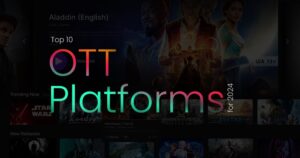
Looking for the best OTT platform for your streaming business in 2024?
We have put together a list of the 10 top OTT platforms for 2024, featuring detailed insights into their key features, pricing, and more.
The rate of OTT video consumption on major platforms is forecasted to rise sharply, with media revenue anticipated to surpass $210 billion by 2026. Building a streaming business is indeed a very complex task, not to mention the challenges of long-term maintenance. The business demands diverse expertise for the development and sustained operation of various OTT platform components.
With this perspective, let’s get into some of the most popular and highly-rated OTT platforms and streaming services globally.

What is an OTT Platform?
An OTT (Over-the-Top) platform refers to a digital platform that enables professional broadcasters to deliver video content directly to viewers over the internet, without the need for traditional distribution methods like cable or satellite. These platforms provide broadcasters with the infrastructure and tools to stream live events, create on-demand content, and reach audiences worldwide. OTT platforms customized for professional broadcasters offer features such as high-quality video streaming, analytics, monetization options, and content management systems to enhance the broadcasting experience.
List of Top 10 OTT Platforms in 2024
1. VDOX
VDOX, a white label ott platform, offers streaming services designed for professional broadcasters. This platform provides both Video on Demand (VOD) and live streaming services, catering to broadcasters’ diverse needs. With a vast set of features, including password protection and user-friendly interface, VDOX ensures secure distribution of video content to a global audience.
Key Features:
- Monetization tools such as SVOD, AVOD, and pay-per-view (TVOD)
- White label and branding customization options
- Adaptive bitrate streaming for optimal viewing experience
- Unlimited viewership and live channel creation
- Advanced video security measures for secure streaming
- Global content delivery through strategic CDN partnerships
- Multi-bitrate streaming capabilities
- Access to Player API and Video API
- 24/7 technical support
Pros:
- Hosting for both VOD and live streams
- Real-time analytics for performance tracking
- Ad-free streaming experience
- Extensive privacy and security tools for content protection
- Compatibility with mobile devices
- Live stream recording feature
- Dedicated China video hosting support
- Flexible pricing plans to suit various budgets
Cons:
- Users may encounter a minor learning curve initially due to the platform’s wide range of features. (However, once familiarized, these features enhance user experience significantly)
2.Accedo
Accedo pioneers video experience solutions, enabling businesses to provide superior viewing experiences across diverse platforms. Focused on innovation and user engagement, Accedo delivers a comprehensive suite of tailored products and services to address the needs of digital media.
Key Features:
- Multi-platform support for seamless streaming across devices
- Customizable user interfaces to enhance brand identity and user experience
- Advanced analytics for actionable insights into viewer behavior
- Scalable architecture to accommodate growing audience demands
- Integration with leading content delivery networks (CDNs)
- Monetization options including subscription and pay-per-view models
Pros:
- Expertise in user engagement and innovation
- Scalable architecture to accommodate growing demands
- Integration with leading content delivery networks
- Varied monetization options for revenue generation
- Data and Analytics for actionable insights
Cons:
- Implementation and configuration may require technical expertise
- Integration challenges with legacy systems or third-party platforms
3. Dacast
Dacast offers a unified streaming platform tailored for streamers. With a focus on VOD and live streaming services, Dacast provides a wide range of powerful OTT content and technology features, ideal for broadcasters seeking secure and efficient distribution of video content worldwide
Key Features:
- White label and branding control for personalized platform development
- Adaptive bitrate streaming for optimal viewing experiences
- Integration with Zoom for enhanced live streaming capabilities
- Expo galleries video portal for curated content showcases
- Unlimited viewership and live channels creation
Pros:
- Flexible pricing plans catering to different budgetary needs
- Real-time analytics for insightful performance tracking
- Ad-free streaming experience enhancing viewer engagement
- Extensive privacy and security features ensuring content protection
- Compatibility with a wide range of devices for maximum reach
Cons:
- Lack of built-in marketing tools for audience engagement
- Extended wait times for customer support responses
4. IBM Cloud Video
IBM Cloud Video stands out with a focus on scalability, reliability, and advanced features, IBM Cloud Video caters to the diverse needs of broadcasters seeking to deliver high-quality video content to audiences worldwide.
Key Features:
- Scalable infrastructure capable of handling large-scale streaming events
- Reliable content delivery network (CDN) for seamless video distribution
- Advanced video analytics for insightful audience engagement metrics
- Secure streaming protocols ensuring content protection and compliance
- Integration with popular streaming platforms for enhanced reach
- Customizable player options for branding and user experience optimization
- Extensive API capabilities for seamless platform integration
Pros:
- Comprehensive data and analytics
- High level of security and compliance measures
- Integration options with leading streaming platforms enhancing reach
Cons:
- Complexity in setup and configuration may require technical expertise
- Higher pricing compared to some other streaming solutions
5. Vimeo Livestream
Vimeo Livestream offers a versatile platform for live broadcasting. With a focus on simplicity, quality, and interactivity, Vimeo Livestream empowers users to engage audiences with professional-grade live video content across various platforms.
Key Features:
- Seamless live streaming to multiple destinations simultaneously
- Interactive features like Q&A, polls, and chat for audience engagement
- Customizable branding options for a personalized broadcasting experience
- Integration with popular platforms like Facebook, YouTube, and LinkedIn
- Dedicated support and resources to assist users
Pros:
- User-friendly interface making it easy to set up and manage live streams
- High-quality video output ensuring professional-grade broadcasts
- Interactive features enhancing viewer engagement and participation
- Comprehensive analytics offering valuable insights for content optimization
Cons:
- Less advanced analytics compared to competitors
- Occasional platform glitches
6. Kaltura
Kaltura is a renowned name in the streaming industry, offering a comprehensive platform for video management, distribution, and monetization. With a focus on flexibility and innovation, Kaltura provides powerful solutions tailored for various industries and use cases.
Key Features:
- Advanced video analytics and reporting tools for actionable insights
- Flexible monetization options including advertising, subscriptions, and pay-per-view
- Interactive video experiences with features like quizzes, polls, and annotations
- Multi-device support for seamless playback
- Customizable branding options for a consistent and branded viewing experience
- Secure content delivery with DRM (Digital Rights Management)
Pros:
- Flexible monetization options enabling revenue generation from video content
- Extensive integrations with third-party systems for seamless workflow integration
- Scalable infrastructure capable of handling large-scale video deployments
Cons:
- Complexity in setup and configuration may require technical expertise
- User interface design could be improved for better usability
- Limited support for certain niche use cases or industry-specific requirements
7. Wistia
Wistia is a reputable player in the streaming industry, renowned for its user-friendly platform tailored for businesses of all sizes. With a focus on providing professional video hosting and marketing solutions, Wistia empowers users to create, manage, and distribute high-quality video content effectively.
Key Features:
- Intuitive video hosting and management interface
- Customizable video player with branding options for a consistent user experience
- Advanced video analytics providing actionable insights into viewer engagement
- Responsive video embedding ensuring optimal playback across devices
- Optimized video SEO tools
Pros:
- User-friendly platform making it easy to create and manage video content
- Comprehensive analytics offering valuable insights for content optimization
- Seamless integration with third-party marketing tools for enhanced functionality
Cons:
- Restrictions on storage capacity
- Limited customization options
- Challenges in managing large video libraries
8. Vidyard
Vidyard is designed to help businesses drive engagement and growth through video content. With a focus on accessibility, analytics, and integrations, Vidyard empowers users to create, manage, and optimize their video marketing efforts effectively.
Key Features:
- User-friendly video creation and hosting platform
- Customizable video player with branding options
- Advanced video analytics providing actionable insights into viewer behavior
- Secure video hosting with password protection and encryption for data security
Pros:
- Intuitive platform making it easy to create, manage, and optimize video content
- Analytics offering valuable insights for content performance optimization
- Seamless integration with third-party marketing tools for enhanced functionality
- Dedicated support and resources to assist users in achieving their video marketing goals
Cons:
- Challenges in managing and organizing large libraries
- Lag or buffering during video playback
9. Wowza
Wowza emerges as a reliable OTT platform tailored for professional broadcasting, offering highly customizable streaming workflows through third-party integrations and advanced features. While its focus on internal business use renders it ineligible for streaming as a service, Wowza remains ideal for marketing endeavors such as product launches and interactive customer sessions.
Key Features:
- Cloud transcoding for optimized video delivery
- Support for both live streaming and VOD (Video on Demand)
- White-label video player for seamless branding integration
- Reliable customer support ensuring smooth operations
Pros:
- Brand customization tools for personalized streaming experiences
- Auto-archiving feature for convenient content management
- Powerful video CMS (Content Management System)
- Ultra HD streaming (4K) for immersive viewing experiences
- Wide range of security options ensuring content protection
Cons:
- Lack of simulcasting tools limiting broadcasting capabilities
- Absence of support for video monetization
- Limited availability of reliable video analytics tools for performance tracking
10. JW Player
JW Player stands as a leading name in the streaming industry, offering a versatile platform for video hosting, streaming, and monetization. Renowned for its ease of use, advanced features, and extensive customization options, JW Player empowers businesses and content creators to deliver engaging video experiences across various devices and platforms.
Key Features:
- Intuitive video player with customizable design options
- Adaptive bitrate streaming
- Support for both live and on-demand streaming
- Advanced video encoding and transcoding capabilities
- Comprehensive API documentation and developer tools
Pros:
- User-friendly interface making it easy to upload and manage video content
- Insights for content optimization and monetization strategies
- Extensive customization options allowing for tailored video player experiences
Cons:
- Performance issues with high-resolution content.
- Higher pricing compared to some other video hosting and streaming solutions
- Potential limitations in API functionality for highly customized integration needs
Conclusion: Which OTT Platform to choose?
As the demand for OTT streaming services continues to grow, selecting the best option requires careful consideration of various factors such as features, pricing, and support. It’s crucial to assess the platform’s scalability, customization options, and compatibility with your specific needs and goals.
Among the number of choices available, VDOX stands out as the optimal solution for professional broadcasters. With its amazing feature set, including white-label OTT platform development, advanced monetization options, and user-friendly interface, VDOX offers flexibility and functionality.
Additionally, its emphasis on scalability, reliability, and dedicated support promises a smooth streaming experience and maximized audience engagement. For broadcasters seeking to game up their streaming endeavors and achieve success, VDOX emerges as the clear frontrunner.
Author Profile

-
Hi I am Karan a passionate blogger. It's almost 4.5 years when I started blog writing in 2019. I am the owner of the Readree.com. My dedication to delivering reliable information and useful tips has earned him a loyal following among tech enthusiasts seeking reliable insights and recommendations.
If You have any query then email Us. sabinbaniya2002@gmail.com
Latest entries
 AppsApril 19, 2025Transfer Money from Bajaj EMI Card to Mobikwik Wallet
AppsApril 19, 2025Transfer Money from Bajaj EMI Card to Mobikwik Wallet TECH NEWSApril 15, 2025What is Bike Pink in Rapido?
TECH NEWSApril 15, 2025What is Bike Pink in Rapido? ArticleApril 9, 2025Top 10 Whisky Brands in India Under 5000 – Indian Whisky Brands
ArticleApril 9, 2025Top 10 Whisky Brands in India Under 5000 – Indian Whisky Brands How ToApril 3, 2025How Many Passengers Are Allowed in a Rapido Cab?
How ToApril 3, 2025How Many Passengers Are Allowed in a Rapido Cab?